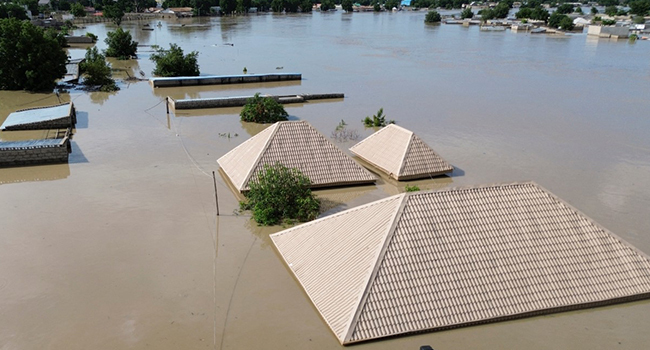
By Sani Danaudi Mohammed
The recent overflow of the Alau Dam unleashed unprecedented flooding in Maiduguri, the Borno state capital, leaving a trail of destruction and despair in its wake. The devastating impact of the floods has resulted in displacement of communities, widespread damage to infrastructure, and significant disruption to daily life. In fact, the people of Maiduguri are struggling to come to terms with the disaster.
The Alau Dam was constructed between 1984 and 1986 to provide water for irrigation and domestic use in Maiduguri. The dam’s reservoir, impounding the Ngadda River, a tributary of Lake Chad, has been a vital source of water supply, supporting agricultural activities and livelihoods of thousands of people. Its economic importance to Borno state cannot be overstated, as it has enabled the growth of crops such as wheat, maize, and rice, contributing significantly to the state’s food security and economy.
The dam’s overflow highlights the importance of maintenance culture, disaster management, and environmental safety. In this article, we will examine the causes and consequences of the Alau Dam flooding, and explore ways to mitigate the impact of such disasters in future. We will also pay tribute to the resilience and strength of the people of Maiduguri, who are already beginning to rebuild and recover from this tragedy.
The Alau Dam flooding has had a debilitating impact on businesses in Maiduguri, with many suffering significant losses due to damaged infrastructure, disrupted supply chains, and lost revenue. Thousands of small-scale entrepreneurs, traders, and artisans have seen their livelihoods severely affected, as floods destroyed goods, equipment, and vital infrastructure.
Major markets, such as the Maiduguri Monday Market, have been destroyed, forcing vendors to temporarily relocate or cease operations altogether. The flooding has also crippled the city’s transportation network, hindering the movement of goods and services. As a result, prices of essential commodities have skyrocketed, exacerbating the economic hardship faced by residents.
The human cost of the flooding has been equally devastating, with tens of thousands of people displaced from their homes and forced to seek shelter in temporary camps. Many families have lost their homes and livelihoods, leaving them vulnerable and dependent on humanitarian aid. The flooding also took a toll on public health, with increased risks of waterborne diseases, such as cholera and malaria.
Children and the elderly have been particularly affected, with many schools and healthcare facilities forced to close due to flooding. The psychological trauma caused by the disaster should not be underestimated, as residents struggle to cope with the loss and uncertainty that surround them. The long-term social and economic consequences of the flooding will likely be felt for years to come.
To prevent future flooding, proactive measures must be taken to enhance the Alau Dam’s capacity and resilience. Regular maintenance and inspections are crucial to ensure the dam’s structural integrity and identify potential vulnerabilities. Additionally, upgrading the dam’s spillway and drainage systems can help regulate water levels and prevent overflow.
Implementing effective water management practices, such as controlled releases during heavy rainfall, can also mitigate flood risk. Furthermore, integrating flood forecasting and early warning systems can provide critical time for evacuation and preparedness. Collaborative efforts between government agencies, local communities, and international organisations are necessary to prioritise dam safety and flood prevention.
Long-term solutions require a holistic approach, incorporating environmental and urban planning strategies. This includes protecting and restoring natural floodplains, wetlands, and watersheds surrounding the dam to enhance water absorption and filtration. Implementing sustainable land-use practices, such as reforestation and soil conservation, can reduce runoff and sedimentation.
Urban planning measures, like flood-resistant construction and elevated buildings, can minimise damage to infrastructure. Establishing flood-risk zones and enforcing zoning regulations can prevent development in high-risk areas. Investing in climate-resilient infrastructure, green infrastructure, and ecosystem-based adaptation can also enhance Maiduguri’s resilience to flooding. Community engagement, education, and participation are vital to ensure that flood prevention and mitigation efforts are effective and sustainable.
Vice President Kashim Shettima visited Maiduguri to assess the flood damage and offer support to affected communities. His visit demonstrated the federal government’s commitment to addressing the crisis. During his visit, he met with state officials, stakeholders, and flood victims, promising prompt intervention and relief measures. The vice president’s presence helped to boost morale and hope among the affected populations, who are struggling to recover from the devastating floods. His visit also facilitated the mobilization of resources and expertise to support the state’s response efforts.
The federal government, through agencies like the North East Development Commission (NEDC), National Refugees Commission (NRC), and National Emergency Management Agency (NEMA), has provided significant interventions to alleviate the suffering of flood victims. These agencies have distributed relief materials, including food, shelter, and medical supplies, to affected communities.
Well-meaning Nigerians, including private organisations and individuals, have also contributed to the relief efforts, donating generously to support the flood victims. The interventions have helped to address the immediate needs of the affected populations, providing a foundation for long-term recovery and rebuilding efforts. The collective response demonstrates the resilience and solidarity of the Nigerian people in the face of adversity.
The Nigerian Army’s swift and selfless rescue operations in Maiduguri have been instrumental in saving countless lives and providing critical assistance to flood victims. Their tireless efforts, often under challenging conditions, have earned widespread praise. Meanwhile, well-meaning Nigerians have rallied to support the relief efforts.
Notably, Alhaji Aliko Dangote donated N2 billion to alleviate the suffering of flood victims, while renowned Kano-based Hausa singer, Dauda Kahutu Rarara, provided food items to support the affected communities, going beyond just lending his voice to the cause. Other individuals and organizations have also contributed generously, demonstrating the nation’s resilience and solidarity. These collective efforts have provided vital succor to affected communities, helping to address immediate needs and pave the way for long-term recovery. The Nigerian spirit of compassion and generosity has shone brightly amidst this tragedy.
The recent flooding in Maiduguri is a stark reminder of the devastating impact of natural disasters on communities across Nigeria. Similar floods have ravaged other parts of the country, including the 2012 Nigeria floods that displaced over 2 million people and the 2018 Benue state flood that left thousands homeless. These recurring disasters highlight the need for proactive measures to mitigate the effects of climate change and improve disaster preparedness. Globally, tragic floods like the 1931 China floods that killed 4 million people, the 2004 Indian Ocean tsunami that affected several countries, and Hurricane Katrina in 2005 that devastated New Orleans, serve as sobering reminders of the destructive power of water.
As Nigeria grapples with the aftermath of the Maiduguri floods, it is essential to draw lessons from these global tragedies and invest in sustainable solutions. This includes strengthening early warning systems, enhancing infrastructure resilience, and promoting ecosystem-based adaptation. By learning from the past and working together, we can reduce the risk of future floods and build more resilient communities. The government, civil society, and individuals must collaborate to address the root causes of flooding and support affected populations. Only through collective action can we mitigate the impact of climate-related disasters and create a safer future for all.
One aspect that brought solace to the victims of this devastating flood was the compassionate leadership displayed by Governor Babagana Zulum, who waded into the flood alongside the affected residents, working closely with rescue teams to alleviate their suffering. This selfless act of empathy and solidarity serves as a powerful example for other state governors and political leaders to follow, demonstrating the importance of identifying with their people in times of crisis and leading by example.
As I bring this to a close, my thoughts are with the flood-affected residents of Maiduguri. I call on the government to act with urgency, delivering immediate aid and long-term solutions to safeguard against future tragedies. May the people of Maiduguri find hope, strength, and support in the face of adversity.
Danaudi writes from Bauchi, Bauchi state via danaudicomrade@gmail.com
The views expressed in this article are the author’s own and do not necessarily reflect the editorial policy of Sky Daily





































